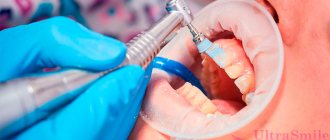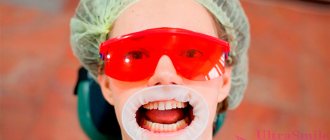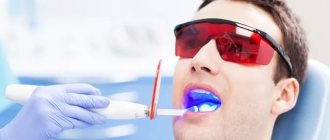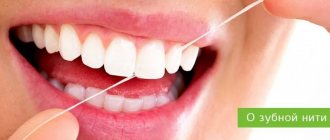Dental calculus is one of the most common pathologies. According to statistics, more than 65% of adults have it. Tartar should not be treated only as an aesthetic defect.
In addition to causing bad breath, tartar is the cause of many dental diseases and promotes infection in the body. Therefore, it is necessary to prevent stone formation, and if it forms, immediate treatment by a dentist.
What is tartar
Tartar is a hard, calcareous deposit on the surface of the tooth that is yellowish to dark brown in color. Initial plaque consists of food debris, dead cells, mucus and microorganisms. The stone is formed when soft plaque accumulates and thickens, and its gradual mineralization with calcium, phosphorus and iron salts. First, it forms in places where plaque accumulates the most: in the gingival zones, in the tooth sockets and in the interdental space. Most often on the inside of the dentition, where there is a hard-to-reach area for brushing teeth and the exit of the salivary gland canals. As the process progresses, it can cover the entire visible surface of the tooth and go under the gums.
Pros and cons of ultrasonic tartar removal
Unlike other methods, ultrasonic cleaning has a number of advantages:
- Removes subgingival calculus that is difficult to reach with traditional instruments. To clean the root zone, the doctor pulls back the gums and works with the neck and root of the tooth.
- Cleans the interdental spaces even of very dense teeth, uneven, overlapping one another.
- The procedure does not last long - 40-60 minutes.
- Painless. The patient does not feel any impact.
- Non-contact influence. Only air and water come into contact with teeth. With the outdated mechanical method, the instruments scratch the enamel and cause an unpleasant “grinding” sensation.
How quickly does a stone form?
The rate of stone formation varies from person to person and depends on hygiene skills and factors contributing to stone formation. In the absence of brushing your teeth, within a few hours after eating, a thick film of a huge number of bacteria feasting and multiplying on food debris forms on the surface of the tooth. After a week, the film thickens due to mineralization processes. On average, it takes about 4–6 months to form a dense stone. Therefore, a preventive examination by a dentist is necessary at least once every six months.
Is it possible to smoke
What you should not do after having your teeth professionally cleaned by the dentist is go back to smoking cigarettes. Nicotine is a powerful colorant, just like coffee and wine. Resins, along with carcinogenic substances, settle on the hard surfaces of incisors, canines and molars, creating an ideal environment for the growth and reproduction of pathogenic microorganisms. Tobacco in general has a negative effect on bone tissue, promoting its destruction and killing beneficial bacteria.
When cleaning is carried out in the dental office, the protective film is removed from the enamel. As a result, the outer layer absorbs resinous compounds and acquires a yellowish tint after just a few days.
Also, during the procedure, the mucous membranes may be damaged. Toxins from cigarettes get inside and provoke a severe inflammatory process that can spread to the entire maxillofacial apparatus.
Smokers often suffer from bleeding, dry and loose gums. The capillaries narrow, and the gum tissue weakens, becomes dehydrated, and the oxygen concentration decreases. Because of this, caries, pulpitis, gingivitis, and periodontal disease occur. If you do not wait for healing and smoke, infection will occur, which can subsequently lead to destruction and loss of teeth.
Symptoms
Signs of tartar:
- using a mirror you can see dark deposits on the teeth near the gums (mostly on the inside), which do not disappear after hygiene procedures;
- darkening of tooth enamel;
- constant bad breath;
- bleeding gums when brushing teeth;
- increased gum sensitivity;
- deepening and widening of gum pockets, exposure of tooth roots.
Only supragingival plaques can be seen visually; subgingival formations are diagnosed by a doctor.
Why is tooth stone dangerous?
In addition to an aesthetic defect, tartar is a common cause of a repulsive putrid odor from the mouth. In addition, stone formation can provoke the development of severe dental diseases:
- caries;
- gingivitis;
- periodontitis;
- tooth loss.
The presence of stone deposits reduces the local immunity of the oral cavity, which increases the proliferation of bacteria and aggravates the manifestation of their pathogenic properties. The consequence of the activity of bacteria is the destruction of tooth enamel and the development of various inflammatory processes in the oropharynx. Subgingival stones destroy the connection between teeth and bone, causing them to loosen and fall out. With severely advanced processes, it is no longer possible to stop tooth loss.
Caries - what is it?
More than 95% of the inhabitants of our planet face the disease. Thus, it can be called the most common dental problem. At the very beginning, the pathological process affects only the enamel, and in the absence of therapy it penetrates into the deep hard layers. Then the soft tissues with nerve fibers and blood vessels become inflamed.
The disease is insidious because in the earliest stages it does not manifest itself in any way, and the patient begins to sound the alarm only when acute pain and a large hole appear that cannot be eliminated by conservative methods.
Causes of tartar
The formation of tartar is a consequence of:
- insufficient or improper oral hygiene;
- disorders of mineral metabolism in the body, which is often associated with the presence of chronic diseases or genetic predisposition.
Factors that contribute to the formation of tartar, subject to insufficient hygiene, include:
- defective position of teeth;
- roughness of the tooth surface, often due to the installation of low-quality filling material or insufficient polishing;
- presence of braces and dentures.
- preference in the diet for soft and carbohydrate foods;
- one-sided chewing;
- smoking;
- alcohol abuse;
- hypersalivation (secretion of large amounts of saliva);
- a general decrease in the body’s immunity and the presence of foci of chronic infection.
Smokers' tartar
There are practically no heavy smokers who do not have tartar. Tar from tobacco smoke and soot deposit a yellow coating on tooth enamel. It is easier for food debris to stick to this plaque and for bacteria to multiply comfortably. Gradually, under the influence of both saliva and tobacco smoke, various salts are deposited in plaque and brown tartar is formed. In addition, tobacco smoke contains toxic substances and heavy metals, which trigger the process of detachment of the gingival margin from the teeth. Food is stuffed into the deep gaps and optimal conditions are created for the growth of colonies of pathogenic bacteria. A regular toothbrush does not sweep out pathological contents from such pockets. And bacteria eat away the connective tissue between teeth and bone, exposing their roots. A dangerous inflammatory disease – periodontitis – gradually develops. Tartar deposited under the gum does not give a chance for self-healing, but turns the disease into a chronic form. Combined with the effects of tartar and destruction of the connective tissue that anchors the teeth, the process of development of periodontitis in smokers proceeds 3 times faster than in non-smokers. This leads to rapid tooth loss. According to statistics, 80-year-old smokers have 2.5 times fewer teeth than non-smokers.
Removing tartar and plaque - it's all about it. Methods for removing tartar. Is it painful to remove tartar with ultrasound? Why are tartar and plaque dangerous? Is it harmful or beneficial to remove tartar and plaque?
Where do tartar and plaque come from? The question is almost rhetorical. Let's figure it out. While eating, the teeth grind food, and small remains inevitably remain in the mouth. They do not linger on the gums and fall into the interdental spaces, which are very convenient for this, where they remain until the next teeth cleaning, which is designed to remove them from there and cleanse the teeth of everything unnecessary. What if there was no traditional evening teeth brushing or some of the food in the mouth remained untouched?
Then healthy microflora of the oral cavity settles in these areas, feeling great there - she is warm and damp, there is enough food, what else does she need? So that she won't be disturbed. And if the brush or floss does not touch it, then the microflora already turns into macroflora, forming plaque on the teeth, which consists of 95% flora and fauna, and the remaining 5% - no matter what. In this case, the microflora turns from normal (natural for the body) into pathological (harmfully affecting the body) not only because of its large quantity, but also changing in its structure and composition, affecting the teeth and gums not very well, causing caries and periodontitis. In addition, the surface of plaque is not smooth, but rough, which improves the adhesion of food debris to it. And the further, the more. When plaque remains for a week or more, it becomes denser and turns into tartar, which no toothbrush or floss can remove. How do tartar and plaque affect a person’s life? The appearance becomes so-so, bad breath may appear, the risk of caries increases, especially if there are fillings, gum inflammation occurs, which leads to periodontitis and tooth mobility. Do tartar and plaque affect teeth? The microbial component of tartar and plaque (which, remember, is 95%) in the process of their vital activity forms acid, which has a destructive effect on tooth enamel. By the way, the oral cavity has an alkaline environment, and it should neutralize all acidity. I would love to, but the same plaque and tartar again bothers her. She cannot penetrate through them to the tooth. Conclusion: Plaque and tartar contribute to the development of caries. And to prevent its occurrence, you need to remove tartar and plaque. Does plaque affect your gums? Certainly! Firstly, it affects it mechanically, especially if it has grown to the level of tartar. And chronic injury leads to gum inflammation. But we remember that tartar consists of pathological flora. How does it affect the gums? This will already happen, secondly: the body is designed in such a way that it strives to remove everything unnecessary, including microbes, sending special blood cells to destroy them. But in the area of inflammation of the mucous membrane, the surface layer, designed to protect and block the path of infection, is damaged, so the flora easily enters the inflamed gum, saturating it through and through. And blood cells, attacking microbes, hit not only them, but also the gums in which they are located. And this again increases the inflammation of the gums, and under the pressure of tartar, plaque, flora and its own blood cells, it retreats and retreats, exposing the roots of the teeth, causing bone atrophy and increasing tooth mobility.
This will be a brief description of periodontitis, which more often begins with a banal plaque, but how it ends - ask the owners of removable dentures. How to live further? With or without plaque, it’s up to you. And if you haven’t yet run to the phone to call your dentist, read on to learn how tartar and plaque are removed.
Methods for removing tartar
Previously, tartar was removed with special hooks. Now this method is used extremely rarely. It is not very pleasant, and most importantly, it does not completely remove tartar. Instead came the method of removing tartar using ultrasound. A special device generates ultrasonic vibrations, thanks to which removable attachments carefully clean the tooth surface without injuring it. Ultrasound removal of tartar occurs not only due to the nozzle touching the tooth surface, but also due to the cavitation effect - strong turbulence of the liquid. In this case, it is not necessary to touch the tartar; it is enough that the nozzle is next to it. Due to cavitation, the tartar itself will fall off the tooth surface. If the tartar is very dense, then lightly touching it with the nozzle is enough, and it will bounce off. There should not be strong pressure, as this will reduce the ultrasonic vibrations, and removing tartar will be similar to removing it with hooks. The cavitation effect is also useful because when removing tartar, oxygen is released from the water, which disinfects the treated area, which, you see, is quite important. In addition, mechanical cleansing of the root and gum surface occurs. Tartar is removed completely, without any residue. Removing tartar is sometimes difficult due to the high density of tartar. Special preparations allow you to soften tartar, after which tartar removal will be much easier and faster. After ultrasonic removal of tartar, the teeth polishing stage occurs. Why is this necessary? So that the surface of the teeth is exceptionally clean and, most importantly, smooth.
Is it painful to remove tartar with ultrasound?
I don’t want to say something trivial, but it’s absolutely painless. The pressure on the tooth when removing tartar is minimal - just to touch the stone and that’s it. Therefore, this is a completely painless procedure. There may be only slight sensitivity to cool water that washes the tooth. This can be easily avoided by using warm water. Tell the hygienist about this - he will warm it up. So simple. As a last resort, anesthesia can be given. But believe me, our experience - such cases can be counted on one hand.
Is it harmful to remove tartar?
Question: Is it harmful or not to wash your car or do a manicure? The answer is most likely no. Even if it’s harmful to do this, then your nails will grow back, and you can change your car. It’s a little more difficult with teeth - they don’t grow, and it’s not easy to change them. Let's try to figure out whether there is harm when removing tartar or how to avoid it. Regarding the harmfulness, they usually say that when removing tartar, the enamel becomes thinner, the teeth are scratched, and plaque will still appear. It is possible to scratch a tooth if you work roughly with hand hooks. With careful removal of tartar using ultrasound, this is excluded. Firstly, the nozzles are not that sharp. Secondly, when the tip is in close contact with the tooth, ultrasonic vibrations stop. Polishing compounds for removing plaque and final polishing are similar in many ways to some toothpastes. Therefore, their use is completely safe for enamel. As they say: even water wears away stones - anything can cause harm. Proper removal of tartar and plaque does not harm the teeth. The benefits of these procedures are obvious - preventing the occurrence of caries and periodontal diseases (periodontal disease and paradontitis).
Prevention of stone deposits
Prevention of any disease is always cheaper than its treatment. This applies not only to the financial component, but also to the temporary and psychological component.
The most important thing in preventing dental diseases is proper oral hygiene.
How to brush your teeth
To prevent the formation of tartar, learn how to brush your teeth correctly:
- Movements when brushing your teeth should be “sweeping”, in the direction from the gums to the edge of the tooth.
- First brush your front teeth, then carefully treat the inner surface of the dentition.
- The chewing surface is cleaned with back-and-forth and circular movements. Don't forget about your wisdom teeth.
- The duration of cleaning should be at least 3 minutes. To do this, it is convenient to have an hourglass in the bathroom or to clean while listening to a certain musical composition.
- Brush your teeth at least twice a day. The first time is after breakfast, the second time after dinner. If you are prone to the formation of stones, brush your teeth additionally after each meal.
Choosing a toothbrush
Not everyone knows how important it is to choose the right brush. Listen to the experts:
- Choose a high-quality, medium-hard toothbrush, preferably with rubber blades, which increase the effectiveness of removing plaque and polishing teeth.
- Soft brushes are only suitable for children or during periods of bleeding and sore gums.
- Hard brushes can be used 1 or 2 times a week. They should not be used in places where the necks of the teeth are exposed, especially if the sawing cleaning is improper. This contributes to the formation of wedge-shaped defects.
- Don't forget to change your brush every month.
Interesting experiment!
American doctors conducted an experiment, the participants of which were divided into 5 groups.
The first group: brushed their teeth with regular brushes and expensive toothpaste for 1 minute.
Second group: brushed their teeth with regular brushes and expensive toothpaste for 5 minutes.
Third group: they brushed their teeth with regular brushes and cheap toothpaste for 5 minutes.
Fourth group: they tried to brush their teeth without a brush, by rubbing expensive toothpaste with their fingers.
Fifth group: brushed their teeth with regular brushes without toothpaste, but for at least 5 minutes.
The experiment lasted a week. Every day after the procedure, the cleanliness of the teeth was measured.
At the end of the week there were the following results (the more stars, the cleaner the teeth):
| Group number | Brushes | Paste | Cleaning time | Result |
| 1 | Regular | Expensive | 1 minutes | Bad result |
| 2 | Regular | Expensive | 5 minutes | Excellent result |
| 3 | Regular | Cheap | 5 minutes | Excellent result |
| 4 | Without brushes | Expensive | 5 minutes | No result |
| 5 | Regular | Without paste | 5 minutes | Good result |
Conclusion: it turned out that when brushing your teeth, the toothbrush and the time spent on the procedure are important. You can brush your teeth even without toothpaste; it will be much more effective than using toothpaste without a brush. And if you clean it correctly, there is almost no difference between expensive or cheap toothpaste.
Other hygiene rules
- For continuous use, use only therapeutic and prophylactic pastes from well-known companies. For people prone to the formation of stones, it is useful to periodically brush their teeth with abrasive whitening pastes, for example, 2 times a week.
- After each meal, thoroughly rinse your mouth with special elixirs, and if you don’t have them on hand, you can use plain water.
- Use floss (special thread) to remove plaque between teeth. Floss is used both after brushing your teeth and without it in the afternoon. However, do not make cutting movements (back and forth), so as not to damage the gums, the movements should be: up and down.
- After brushing your teeth, use special devices - irrigators, which, under the pressure of a stream of water, will clean all places that are difficult for a brush to reach from bacteria and food, and improve blood circulation in the gums and dental pulp. In addition, you can polish your teeth with a special irrigator attachment, then it will be more difficult for the stone to be deposited on smooth enamel. Today, irrigators are recognized by dentists as one of the most effective ways to prevent tartar.
- Quit smoking completely. Or, at worst, use electronic cigarettes, the vapor of which does not contain toxic substances and resins involved in the formation of stones.
- Get a preventive examination from your dentist at least once a year, and more often if indicated.
- Have your teeth professionally cleaned periodically.
Home Remedies
Home remedies for plaque removal are rather preventative. In order to maintain dental health, it is necessary to follow the rules of hygiene:
- Brush your teeth twice a day with a toothbrush and suitable toothpaste.
- Use toothpicks and dental floss after meals, as the brush cannot reach hard-to-reach places.
- Use mouthwash regularly.
Small plaque can be removed using pastes containing abrasives or tooth powder. When using them you need to be careful, as you can damage not only the enamel, but also the mucous membrane of the gums. You need to be even more careful if you decide to remove plaque from your teeth with whitening agents - soda, hydrogen peroxide. Their uncontrolled use can cause problems with dental health.
Ultrasonic toothbrushes
Recently, a new gadget has appeared on the market - an ultrasonic toothbrush. In addition to mechanical cleaning, this brush provides ultrasonic treatment of hard-to-reach areas of the tooth and gums to a depth of up to 4 mm. Ultrasonic waves destroy bacteria and effectively remove pigmentation and deposits when mineralization begins. However, such a brush cannot remove formed tartar; this can only be done by a specialist using professional equipment. In addition, the use of an ultrasonic brush is effective and safe only for people with absolutely healthy teeth.
Contraindications to ultrasonic brushes
Due to the presence of ultrasonic microvibration, the use of such brushes is not recommended for persons:
- with veneers, fillings and crowns, as their service life is reduced;
- with areas of loose and porous enamel, due to the fact that the development of the carious process accelerates due to the destruction of defective enamel;
- with gingivitis and periodontitis, due to the increased spread of infection by hematogenous route;
- with periodontal disease, as the process of bone destruction accelerates;
- having precancerous changes and cancer, due to the acceleration of the division of atypical cells.
These significant drawbacks significantly limit the use of ultrasonic brushes, since almost 95% of the adult population have certain problems. It is also not recommended to use any power brushes during pregnancy or for people with pacemakers.
Does genetics have an effect?
Some researchers attribute individual susceptibility to dental caries to genetic factors. By studying the development of caries in animal models, Japanese scientists suggested that loci on chromosomes 1, 2, 7, 8 and 17 contribute to susceptibility to caries. Genetics does not directly influence the onset of the disease, but determines its severity and duration. This is explained by the peculiarities of the structure of the oral cavity: genes involved in the development of enamel, in the formation and composition of saliva, and also those involved in the formation of the immune response are closely studied [4], [8], [9].
Hardware ultrasonic cleaning.
This is the most popular and effective way to remove mineral deposits. Ultrasonic waves break up tartar and easily remove it from the enamel surface. Moreover, such cleaning has an antiseptic effect and is therefore also indicated for gum inflammation. If the stone formation is very dense, before the cleaning procedure, means are used to soften it, then ultrasonic removal of deposits is carried out. During ultrasonic cleaning in the area of the neck of the lower incisors, when the roots are exposed, there may be mild pain. Then, at the request of the patient, local anesthesia is applied.
Despite the presence of many contraindications for the use of ultrasonic toothbrushes, the use of ultrasonic cleaning when removing stone is necessary. First, the dentist will use visual guidance to avoid areas of thinned, porous enamel. Secondly, one-time professional cleaning does not have as negative an effect on fillings as twice-daily brushing.
Laser cleaning.
The newest non-contact method of removing hard dental deposits is highly effective and absolutely painless. However, the price is much more expensive than ultrasonic. Laser cleaning has the same contraindications as ultrasonic cleaning.
Air-flow
Refers to mechanical methods. A jet of air with a therapeutic abrasive mixture is supplied under pressure, which removes both soft plaque and hard deposits. The gum area may tingle during the procedure. It is less effective than ultrasonic and laser cleaning.
Manual method
Mechanical manual method of beating stones using special tools. Currently, it is outdated due to the painfulness of the procedure, the presence of complications and the emergence of more effective methods. It is used free of charge under the compulsory medical insurance policy in public hospitals or as an additional method of treatment if indicated. Due to the painfulness of the procedure, especially when removing subgingival stones, local anesthesia is performed. It is a relative contraindication for periodontitis due to high trauma.
When it might be painful or unpleasant
Ultrasonic cleaning is a modern, effective method with minimal trauma. Most patients tolerate the process without discomfort.
Pain when cleaning with ultrasound
Pain can occur due to individual characteristics or due to erroneous actions of the doctor.
Features include thin, sensitive enamel - a semblance of shocks and pressure is felt. Weakened gums that are prone to bleeding are easily subject to microdamage and painful sensations appear. If there is extensive subgingival calculus, the doctor works in this area for a long time, which can also lead to discomfort.
Is there any discomfort during laser cleaning?
This method does not cause pain. The laser beam destroys pigments and evaporates water in hard and soft deposits. Their remains are washed off from the surface with water. In this case, there is no effect on the enamel. Gum pockets are not treated with laser; therefore, there is no contact with soft tissues.
Features of chemical tartar removal
The method is rarely used, because has few advantages, including speed and affordable price. Chemical removal has more disadvantages: thinning of the enamel, possible burns of the mucous membrane if performed incorrectly, poor cleaning of the interdental space, allergies to the products used, oxidation of orthodontic metal structures.
Sequencing:
- installation of protective plates on the gums,
- applying acidic and alkaline compounds for 2-3 minutes,
- rinsing, polishing, fluoridation.
Chemical removal of tartar
How painful is it to remove stone manually?
This contact method can only be painful if the doctor's hand accidentally slips and the instrument scratches the gum. Also, the disadvantages include incomplete removal of plaque and stone in hard-to-reach places. Mechanical cleaning is contraindicated for thin, sensitive enamel, inflammation of the gums, and infectious lesions of the mucous membrane.
Nowadays, dentists recommend removing tartar manually less and less often.
After the procedure
At the end of the procedure, regardless of the method of stone removal, the dentist must grind and thoroughly polish the enamel.
Sometimes, at the request of the patient, after cleaning, the teeth are coated with a special protective composition against infection and plaque buildup.
Within 15 days after cleaning:
- Do not use bleaching abrasive pastes;
- the use of toothpastes from the “sensitive” series, based on herbs and with an anti-inflammatory effect, is indicated;
- rinses with astringent and soothing properties are recommended;
- Do not eat spicy foods or dyes;
- categorically give up smoking or at least abstain for this period.
Causes of enamel hyperesthesia
Many patients complain of increased sensitivity of teeth after tartar removal. The main reason for such complaints is the exposure of hard tooth tissues that were previously covered with tartar. The deposits partially reduced the impact of irritants - high and low temperatures, sour, sweet and spicy foods. Therefore, after the stone is removed, the enamel reacts more sharply to external factors.
Increased tooth sensitivity is caused by:
- existing diseases of the oral cavity - caries, pulpitis,
- thinning of tooth enamel in the cervical area,
- non-compliance with professional cleaning rules.
To reduce the likelihood of enamel hyperesthesia, have your teeth cleaned only by qualified dentists. Contact only experienced specialists in whose professionalism you are confident.
Are there any traditional methods for removing stones?
There are no home methods to remove stones in one procedure, like in clinics. Moreover, with extensive and long-fossilized formations, traditional methods will not help. Grandmother's recipes can only be used when stone formation begins, when the deposits are thick, but still loose and light. In this case, the following will help:
- cleansing teeth with radish pieces;
- It is also useful to eat a salad of grated radish with lemon every day;
- brush your teeth with fresh and already cooled coal ash;
- soften plaque with hydrogen peroxide, then brush your teeth with soda.
It should be noted that the first two methods will definitely not cause harm; they can be safely used, even if they do not help. But the last two options do not have clinical trials and proven effectiveness, and therefore may be unsafe. Therefore, you should not take such dubious and radical measures on your own when dental care is available to everyone.
Contraindications
Contraindications for hardware teeth cleaning include:
- wearing dentures and braces;
- the presence of implants in the body, including pacemakers;
- ARVI, active stage of tuberculosis, HIV infection;
- oncological diseases;
- pregnancy (or with the permission of an obstetrician-gynecologist);
- childhood, until all baby teeth are replaced.
- pregnancy.
Pregnancy is a relative contraindication to dental cleaning. Dental procedures can be performed during a satisfactory pregnancy with the permission of an obstetrician-gynecologist. If there is a threat of miscarriage or other serious conditions, it will be recommended to postpone the removal of stone deposits and the beauty of the smile.











